high beam SKODA ROOMSTER 2013 1.G Owner's Manual
[x] Cancel search | Manufacturer: SKODA, Model Year: 2013, Model line: ROOMSTER, Model: SKODA ROOMSTER 2013 1.GPages: 219, PDF Size: 13.83 MB
Page 46 of 219

Turn signal and main beam lightsFig. 23
Operating lever: Turn signal and
main beam operation
First read and observe the introductory information and safety warn-
ings on page 41.
The parking light is controlled with the control stalk » page 45.
Control stalk positions » Fig. 23 .
Switch on right turn signal
Switch on left turn signal
Switch on high beam (spring-loaded position)
Switch off main beam and headlamp flasher (spring-loaded position)
When the left or right turn signal is on, the
or
warning light flashes in the
instrument cluster.
When the high beam or headlight flasher is on, the
warning light lights up in
the instrument cluster.
Turn signal for changing lanes - to flash only briefly, move the stalk up or down to
the pressure point only and hold it in this position.
Convenience turn signal If you wish to flash three times only, briefly push the stalk to the upper or lower
pressure point and release again.
WARNINGOnly turn on the main beam or the headlight flasher if other road users will
not be dazzled.ABCDNote■ The main beam can only be switched on when the low beam lights are on.■The headlight flasher can be operated even if the ignition is switched off.■
The turn signal system only operates when the ignition is switched on.
■
The turn signal is automatically cancelled after negotiating a curve.
■
The warning light flashes at twice its normal rate if a bulb for the turn signal
light fails.
Halogen projector headlights with cornering light function
First read and observe the introductory information and safety warn-
ings
on page 41.
For a better cornering illumination, the halogen projector headlights with corner-
ing light function are set in the optimal position in line with the vehicle speed and
the steering angle.
WARNINGIf the halogen projector headlights with cornering light function are faulty, the
headlights are automatically lowered to the emergency position, which pre- vents a possible dazzling of oncoming traffic. Thus the illuminated length of
the road is shortened. Drive carefully and visit a specialist garage as soon as possible.
43Lights and visibility
Page 47 of 219
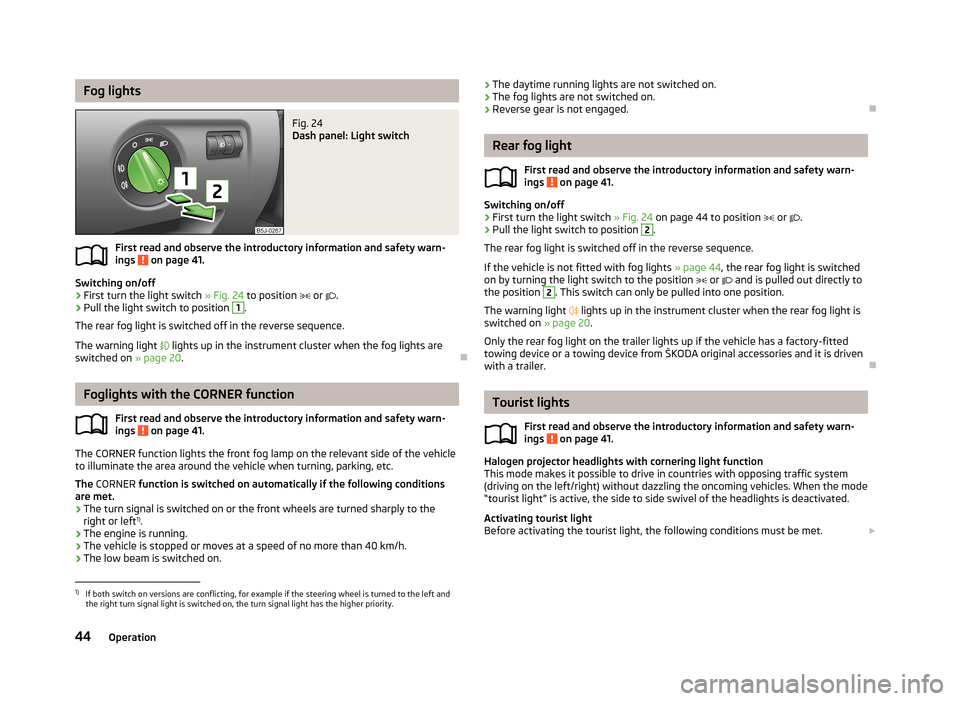
Fog lightsFig. 24
Dash panel: Light switch
First read and observe the introductory information and safety warn-ings on page 41.
Switching on/off
›
First turn the light switch » Fig. 24 to position
or
.
›
Pull the light switch to position
1
.
The rear fog light is switched off in the reverse sequence.
The warning light
lights up in the instrument cluster when the fog lights are
switched on » page 20.
Foglights with the CORNER function
First read and observe the introductory information and safety warn-ings
on page 41.
The CORNER function lights the front fog lamp on the relevant side of the vehicle
to illuminate the area around the vehicle when turning, parking, etc.
The CORNER function is switched on automatically if the following conditions
are met.
› The turn signal is switched on or the front wheels are turned sharply to the
right or left 1)
.
› The engine is running.
› The vehicle is stopped or moves at a speed of no more than 40 km/h.
› The low beam is switched on.
›
The daytime running lights are not switched on.
› The fog lights are not switched on.
› Reverse gear is not engaged.
Rear fog light
First read and observe the introductory information and safety warn-
ings
on page 41.
Switching on/off
›
First turn the light switch » Fig. 24 on page 44 to position or .
›
Pull the light switch to position
2
.
The rear fog light is switched off in the reverse sequence.
If the vehicle is not fitted with fog lights » page 44, the rear fog light is switched
on by turning the light switch to the position
or
and is pulled out directly to
the position
2
. This switch can only be pulled into one position.
The warning light
lights up in the instrument cluster when the rear fog light is
switched on » page 20.
Only the rear fog light on the trailer lights up if the vehicle has a factory-fitted
towing device or a towing device from ŠKODA original accessories and it is driven
with a trailer.
Tourist lights
First read and observe the introductory information and safety warn-ings
on page 41.
Halogen projector headlights with cornering light function
This mode makes it possible to drive in countries with opposing traffic system
(driving on the left/right) without dazzling the oncoming vehicles. When the mode
“tourist light” is active, the side to side swivel of the headlights is deactivated.
Activating tourist light
Before activating the tourist light, the following conditions must be met.
1)
If both switch on versions are conflicting, for example if the steering wheel is turned to the left and
the right turn signal light is switched on, the turn signal light has the higher priority.
44Operation
Page 111 of 219
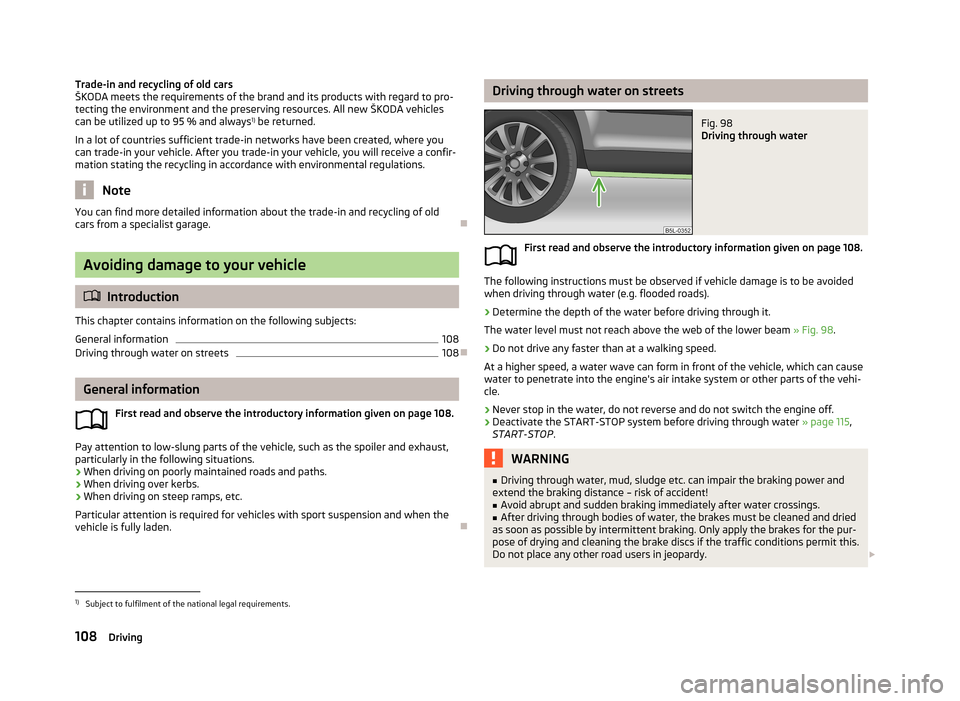
Trade-in and recycling of old cars
ŠKODA meets the requirements of the brand and its products with regard to pro-
tecting the environment and the preserving resources. All new ŠKODA vehicles
can be utilized up to 95 % and always 1)
be returned.
In a lot of countries sufficient trade-in networks have been created, where you can trade-in your vehicle. After you trade-in your vehicle, you will receive a confir-
mation stating the recycling in accordance with environmental regulations.
Note
You can find more detailed information about the trade-in and recycling of old
cars from a specialist garage.
Avoiding damage to your vehicle
Introduction
This chapter contains information on the following subjects:
General information
108
Driving through water on streets
108
General information
First read and observe the introductory information given on page 108.
Pay attention to low-slung parts of the vehicle, such as the spoiler and exhaust,particularly in the following situations.
› When driving on poorly maintained roads and paths.
› When driving over kerbs.
› When driving on steep ramps, etc.
Particular attention is required for vehicles with sport suspension and when the vehicle is fully laden.
Driving through water on streetsFig. 98
Driving through water
First read and observe the introductory information given on page 108.
The following instructions must be observed if vehicle damage is to be avoided
when driving through water (e.g. flooded roads).
›
Determine the depth of the water before driving through it.
The water level must not reach above the web of the lower beam » Fig. 98.
›
Do not drive any faster than at a walking speed.
At a higher speed, a water wave can form in front of the vehicle, which can cause
water to penetrate into the engine's air intake system or other parts of the vehi- cle.
›
Never stop in the water, do not reverse and do not switch the engine off.
›
Deactivate the START-STOP system before driving through water » page 115,
START-STOP .
WARNING■
Driving through water, mud, sludge etc. can impair the braking power and
extend the braking distance – risk of accident!■
Avoid abrupt and sudden braking immediately after water crossings.
■
After driving through bodies of water, the brakes must be cleaned and dried
as soon as possible by intermittent braking. Only apply the brakes for the pur-
pose of drying and cleaning the brake discs if the traffic conditions permit this.
Do not place any other road users in jeopardy.
1)
Subject to fulfilment of the national legal requirements.
108Driving
Page 196 of 219
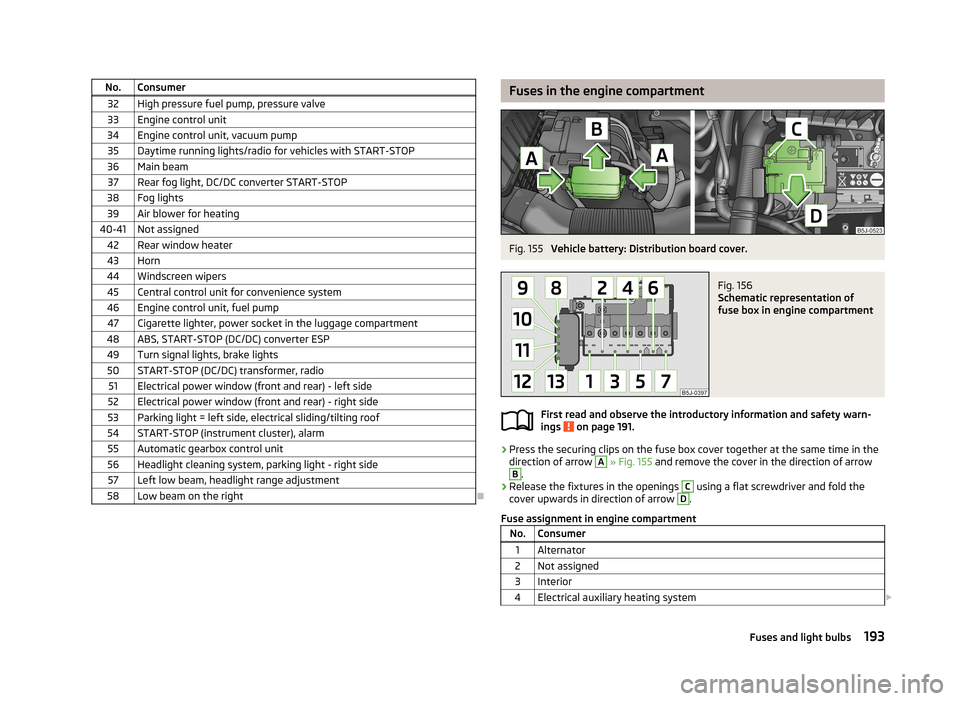
No.Consumer32High pressure fuel pump, pressure valve33Engine control unit34Engine control unit, vacuum pump35Daytime running lights/radio for vehicles with START-STOP36Main beam37Rear fog light, DC/DC converter START-STOP38Fog lights39Air blower for heating40-41Not assigned42Rear window heater43Horn44Windscreen wipers45Central control unit for convenience system46Engine control unit, fuel pump47Cigarette lighter, power socket in the luggage compartment48ABS, START-STOP (DC/DC) converter ESP49Turn signal lights, brake lights50START-STOP (DC/DC) transformer, radio51Electrical power window (front and rear) - left side52Electrical power window (front and rear) - right side53Parking light = left side, electrical sliding/tilting roof54START-STOP (instrument cluster), alarm55Automatic gearbox control unit56Headlight cleaning system, parking light - right side57Left low beam, headlight range adjustment58Low beam on the right
Fuses in the engine compartmentFig. 155
Vehicle battery: Distribution board cover.
Fig. 156
Schematic representation of
fuse box in engine compartment
First read and observe the introductory information and safety warn-
ings on page 191.
› Press the securing clips on the fuse box cover together at the same time in the
direction of arrow
A
» Fig. 155 and remove the cover in the direction of arrow
B
.
› Release the fixtures in the openings
C
using a flat screwdriver and fold the
cover upwards in direction of arrow
D
.
Fuse assignment in engine compartment
No.Consumer1Alternator2Not assigned3Interior4Electrical auxiliary heating system 193Fuses and light bulbs
Page 197 of 219

No.Consumer5Interior6Glow plugs, radiator fan7Electrohydraulic power steering8ABS or TCS or ESC9Radiator fan10Automatic gearbox11ABS or TCS or ESC12Central control unit13Electrical auxiliary heating system
Note
Fuses 1-7 are replaced by a specialist garage.
Bulbs
Introduction
This chapter contains information on the following subjects:
Headlights
195
Changing the low beam and high beam bulb (halogen headlights)
195
Changing the high beam bulb (halogen projector headlights)
195
Changing the high beam bulb (halogen projector headlights)
196
Changing the front turn signal bulb
196
Changing the front parking light bulb
196
Fog lights and daytime running lights
196
Fog light, Roomster Scout
197
Replacing the bulb for the licence plate light
197
Tail light
198
Some manual skills are required to change a bulb. For this reason, we recommend
having bulbs replaced by a specialist garage or seeking other expert help in the
event of any uncertainties.
› Switch off the ignition and all of the lights before replacing a bulb.
› Faulty bulbs must only be replaced with the same type of bulbs. The designa-
tion is located on the light socket or the glass bulb.
› A stowage compartment for replacement bulbs is located in a plastic box in the
spare wheel or underneath the floor covering in the boot.WARNING■ Accidents can be caused if the road in front of the vehicle is not sufficiently
illuminated and the vehicle cannot or can only be seen with difficulty by other
road users.■
Always read and observe the warnings before completing any work in the
engine compartment » page 159, Engine compartment .
■
Bulbs H7 and H4 are pressurised and may burst when changed - there is a
risk of injury. We therefore recommended wearing gloves and safety glasses
when changing a bulb.
CAUTION
■ Do not take hold of the glass bulb with naked fingers (even the smallest
amount of dirt reduces the working life of the light bulb). Use a clean cloth, nap-
kin, or similar.■
When removing and installing the number plate light and tail light make sure
that the paintwork of the vehicle and the tail light are not damaged.
Note
■ This Owner's Manual only describes the replacement of bulbs where it is possi-
ble to replace the bulbs on your own without any complications arising. Other bulbs must be replaced by a specialist garage.■
We recommend that a box of replacement bulbs always be carried in the vehi-
cle. Replacement bulbs can be purchased from ŠKODAOriginal Accessories.
■
We recommend having the headlight settings checked by a specialist garage af-
ter replacing a bulb in the main or low beam.
■
Visit a specialist garage if an LED is faulty.
194Do-it-yourself
Page 198 of 219
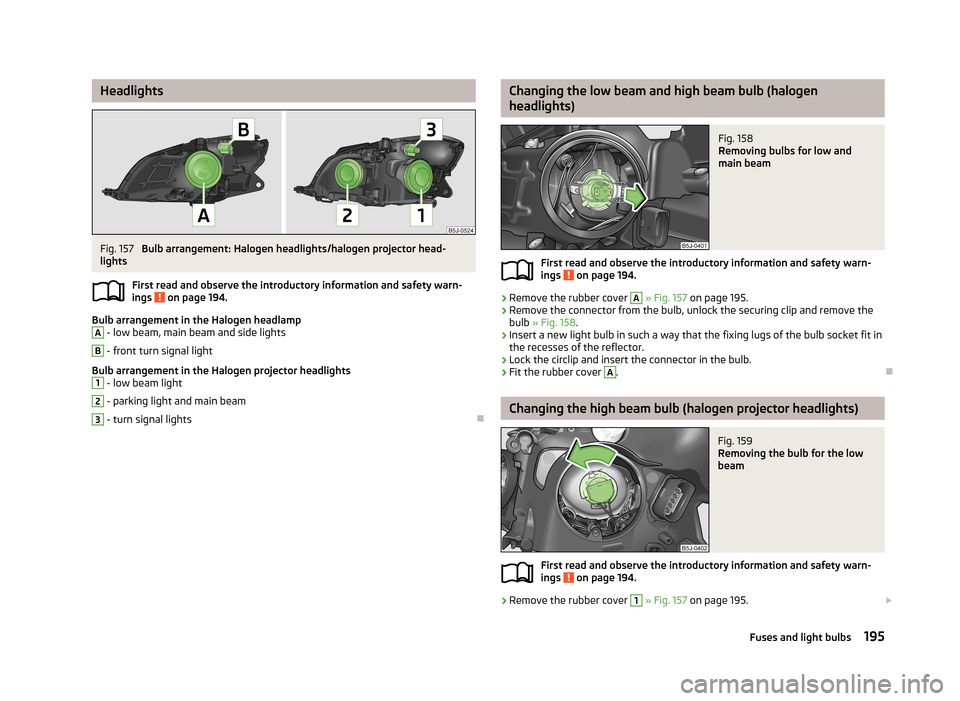
HeadlightsFig. 157
Bulb arrangement: Halogen headlights/halogen projector head-
lights
First read and observe the introductory information and safety warn-ings
on page 194.
Bulb arrangement in the Halogen headlamp
A
- low beam, main beam and side lights
B
- front turn signal light
Bulb arrangement in the Halogen projector headlights
1
- low beam light
2
- parking light and main beam
3
- turn signal lights
Changing the low beam and high beam bulb (halogen
headlights)Fig. 158
Removing bulbs for low and
main beam
First read and observe the introductory information and safety warn-
ings on page 194.
›
Remove the rubber cover
A
» Fig. 157 on page 195.
›
Remove the connector from the bulb, unlock the securing clip and remove the
bulb » Fig. 158 .
›
Insert a new light bulb in such a way that the fixing lugs of the bulb socket fit in
the recesses of the reflector.
›
Lock the circlip and insert the connector in the bulb.
›
Fit the rubber cover
A
.
Changing the high beam bulb (halogen projector headlights)
Fig. 159
Removing the bulb for the low
beam
First read and observe the introductory information and safety warn-
ings on page 194.
›
Remove the rubber cover
1
» Fig. 157 on page 195.
195Fuses and light bulbs
Page 199 of 219

›Turn the socket with the bulb to the stop in the direction of the arrow
» Fig. 159
and remove it.›
Replace the bulb, insert the connector and new bulb and turn to the stop in the
opposite direction to that of the arrow.
›
Fit the rubber cover
1
.
Changing the high beam bulb (halogen projector headlights)
Fig. 160
Removing the bulb for the main
beam
First read and observe the introductory information and safety warn-
ings on page 194.
›
Remove the rubber cover
2
» Fig. 157 on page 195.
›
Turn the socket with the bulb to the stop in the direction of the arrow » Fig. 160
and remove it.
›
Replace the bulb, insert the connector and new bulb and turn to the stop in the
opposite direction to that of the arrow.
›
Fit the rubber cover
2
.
Changing the front turn signal bulb
First read and observe the introductory information and safety warn-ings
on page 194.
›
Remove the bulb holder
B
» Fig. 157 on page 195 or the bulb holder
3
to the
stop in an anti-clockwise direction and remove with the bulb for the turn signal.
›
Replace the bulb, insert the bulb holder with the new bulb and turn clockwise
to the stop.
Changing the front parking light bulb
First read and observe the introductory information and safety warn-
ings
on page 194.
›
Remove rubber cover
A
» Fig. 157 on page 195 or
2
.
›
Grasp the lamp holder and remove it from the bulb housing.
›
Replace the light bulb and insert the lamp holder back into the headlamp with
the bulb.
›
Fit the rubber cover.
Fog lights and daytime running lights
Fig. 161
Front bumper: Protective grille/removing the fog light
First read and observe the introductory information and safety warn-
ings
on page 194.
Bulb location » Fig. 161.
A
- Bulb for daylight driving light
B
- Light bulb for fog lights
Removing the cap
›
Grasp the protective grille in the areas marked by the arrows » Fig. 161 -
and
remove the cover in the direction of the arrow.
Replacing light bulbs for fog lights/daytime running lights
›
Insert your hand into the opening in the protective grille and press the catch » Fig. 161 -
in the direction of the arrow.
›
Remove the fog lamp.
196Do-it-yourself
Page 210 of 219
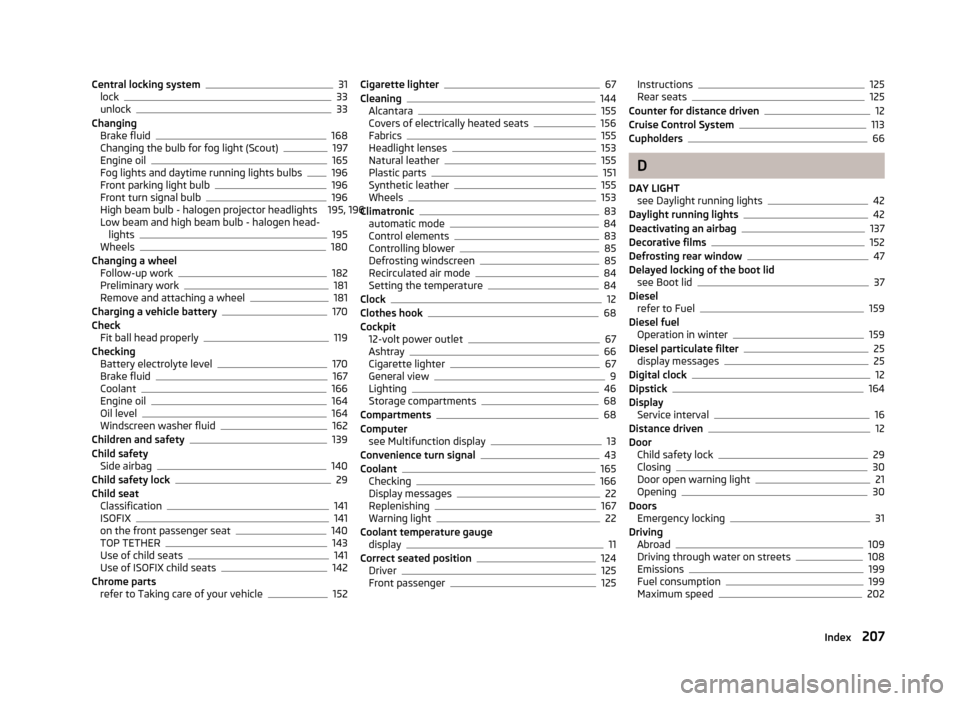
Central locking system31
lock33
unlock33
Changing Brake fluid
168
Changing the bulb for fog light (Scout)197
Engine oil165
Fog lights and daytime running lights bulbs196
Front parking light bulb196
Front turn signal bulb196
High beam bulb - halogen projector headlights 195, 196
Low beam and high beam bulb - halogen head- lights
195
Wheels180
Changing a wheel Follow-up work
182
Preliminary work181
Remove and attaching a wheel181
Charging a vehicle battery170
Check Fit ball head properly
119
Checking Battery electrolyte level
170
Brake fluid167
Coolant166
Engine oil164
Oil level164
Windscreen washer fluid162
Children and safety139
Child safety Side airbag
140
Child safety lock29
Child seat Classification
141
ISOFIX141
on the front passenger seat140
TOP TETHER143
Use of child seats141
Use of ISOFIX child seats142
Chrome parts refer to Taking care of your vehicle
152
Cigarette lighter67
Cleaning144
Alcantara155
Covers of electrically heated seats156
Fabrics155
Headlight lenses153
Natural leather155
Plastic parts151
Synthetic leather155
Wheels153
Climatronic83
automatic mode84
Control elements83
Controlling blower85
Defrosting windscreen85
Recirculated air mode84
Setting the temperature84
Clock12
Clothes hook68
Cockpit 12-volt power outlet
67
Ashtray66
Cigarette lighter67
General view9
Lighting46
Storage compartments68
Compartments68
Computer see Multifunction display
13
Convenience turn signal43
Coolant165
Checking166
Display messages22
Replenishing167
Warning light22
Coolant temperature gauge display
11
Correct seated position124
Driver125
Front passenger125
Instructions125
Rear seats125
Counter for distance driven12
Cruise Control System113
Cupholders66
D
DAY LIGHT see Daylight running lights
42
Daylight running lights42
Deactivating an airbag137
Decorative films152
Defrosting rear window47
Delayed locking of the boot lid see Boot lid
37
Diesel refer to Fuel
159
Diesel fuel Operation in winter
159
Diesel particulate filter25
display messages25
Digital clock12
Dipstick164
Display Service interval
16
Distance driven12
Door Child safety lock
29
Closing30
Door open warning light21
Opening30
Doors Emergency locking
31
Driving Abroad
109
Driving through water on streets108
Emissions199
Fuel consumption199
Maximum speed202
207Index
Page 214 of 219
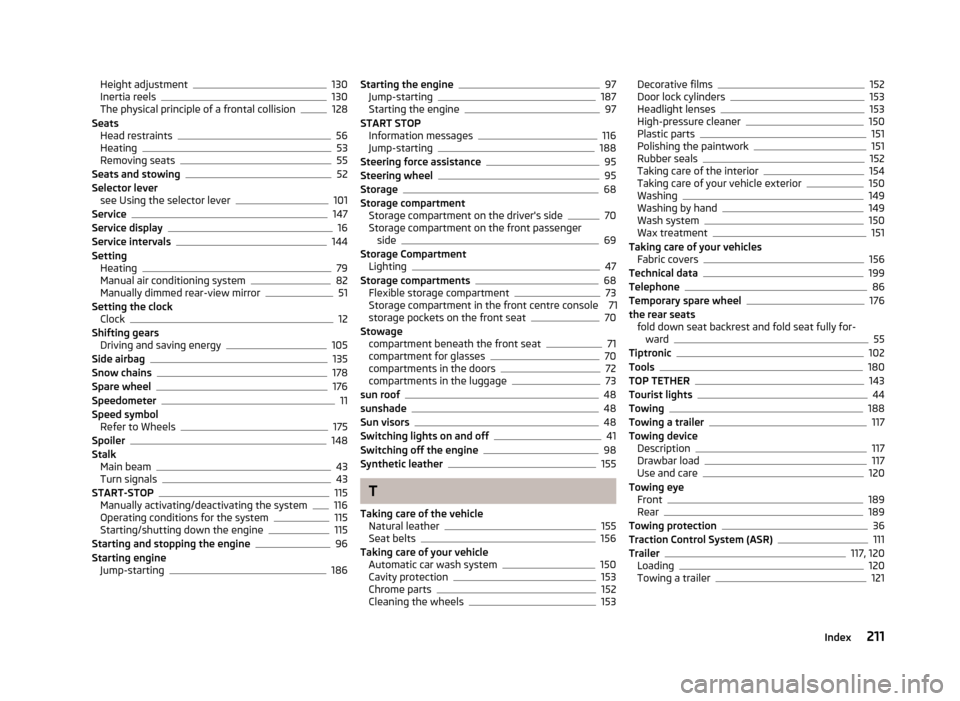
Height adjustment130
Inertia reels130
The physical principle of a frontal collision128
Seats Head restraints
56
Heating53
Removing seats55
Seats and stowing52
Selector lever see Using the selector lever
101
Service147
Service display16
Service intervals144
Setting Heating
79
Manual air conditioning system82
Manually dimmed rear-view mirror51
Setting the clock Clock
12
Shifting gears Driving and saving energy
105
Side airbag135
Snow chains178
Spare wheel176
Speedometer11
Speed symbol Refer to Wheels
175
Spoiler148
Stalk Main beam
43
Turn signals43
START-STOP115
Manually activating/deactivating the system116
Operating conditions for the system115
Starting/shutting down the engine115
Starting and stopping the engine96
Starting engine Jump-starting
186
Starting the engine97
Jump-starting187
Starting the engine97
START STOP Information messages
116
Jump-starting188
Steering force assistance95
Steering wheel95
Storage68
Storage compartment Storage compartment on the driver's side
70
Storage compartment on the front passenger side
69
Storage Compartment Lighting
47
Storage compartments68
Flexible storage compartment73
Storage compartment in the front centre console 71
storage pockets on the front seat
70
Stowage compartment beneath the front seat
71
compartment for glasses70
compartments in the doors72
compartments in the luggage73
sun roof48
sunshade48
Sun visors48
Switching lights on and off41
Switching off the engine98
Synthetic leather155
T
Taking care of the vehicle Natural leather
155
Seat belts156
Taking care of your vehicle Automatic car wash system
150
Cavity protection153
Chrome parts152
Cleaning the wheels153
Decorative films152
Door lock cylinders153
Headlight lenses153
High-pressure cleaner150
Plastic parts151
Polishing the paintwork151
Rubber seals152
Taking care of the interior154
Taking care of your vehicle exterior150
Washing149
Washing by hand149
Wash system150
Wax treatment151
Taking care of your vehicles Fabric covers
156
Technical data199
Telephone86
Temporary spare wheel176
the rear seats fold down seat backrest and fold seat fully for- ward
55
Tiptronic102
Tools180
TOP TETHER143
Tourist lights44
Towing188
Towing a trailer117
Towing device Description
117
Drawbar load117
Use and care120
Towing eye Front
189
Rear189
Towing protection36
Traction Control System (ASR)111
Trailer117, 120
Loading120
Towing a trailer121
211Index